If you love RV life as much as we do, chances are you’ve already exposed your ride to the rigors of Mother Nature – and then some. Even if you’re cruising about in a top-of-the-line rig with a brand new build, your beloved RV is going to develop a few cracks and crevices in her roof sooner or later.
But don’t stress, because fixing a leaky RV roof is an easy DIY job that doesn’t require any technical skills. First things first, however, you’ll need to pick out the perfect sealant product for your needs. And that’s where our in-depth buyer’s guide and top 10 recommendations come into play.
So listen up, because we’re about to provide you with all the info you need to find the ideal sealant or coating—that way, you’ll never have to suffer through a leaky RV roof again.
- Factors to Consider in RV Sealant and Coatings
- Top 10 Best RV Roof Sealants and Coatings 2025
- 1. Best RV Sealant Overall: Sikaflex-221
- 2. Best Premium RV Roof Sealant and Coating: Heng’s Rubber Roof Coating
- 3. Best Budget RV Sealant and Coating: Dicor 501LSW-1
- 4. Best Multipurpose RV Sealant: Flex Seal Liquid Rubber
- 5. Best RV Tape Sealant: EternaBond RSW-2-50 RoofSeal Sealant Tape
- 6. Best RV Roof Rubber Coating: KST Coating Elastomeric Finish Coat
- 7. Best for Fiberglass Roofs: Dicor Fiberglass RV Roof Coating
- 8. Best for Metal Roofs: Dicor RP-MRC-1 Elastomeric Coating
- 9. Best Transparent RV Sealant: Geocel GC28100 Pro Flex RV
- 10. Best Self-Leveling Sealant: ToughGrade Self-Leveling RV Lap Sealant
- RV Roof Sealants and Coatings: A Buyer’s Guide
- RV Sealant and Coating FAQ
- Final Thoughts
Factors to Consider in RV Sealant and Coatings
Before we delve into our top ten list of RV coatings and sealants, you must understand what the key features to consider are. Keep the following points in mind when shopping for a sealant or coating to use on your rig. More information about each of these factors is in our full guide below.
Material Compatibility
Almost all RVs on the market use one of four different materials in the roof: EPDM rubber, TPO rubber, fiberglass, or aluminum. The ideal product for you depends on the material you’ve got up top, so the first thing you need to do is climb up and have a look.
Sealant or Coating
Although some products serve as an RV sealant and coating in one, that isn’t always the case. Sealants are specially designed to fill in cracks, while coatings add UV, moisture, and heat resistance to the entire surface area of the roof. Choose accordingly.
Formula Type
RV sealants and coatings come in varying formula types—silicone, urethane, and acrylic—each of which has its distinct pros and cons. See our section on sealant and coating formula types in our full guide to determine what will work best for you.
Consistency Type
RV sealants and coatings also come in three consistency types: putty (typically silicone), liquid (acrylic or urethane), and tape (varies). Each has its pros and cons, which you can learn about in our consistency type section.
Durability
All RV sealants are designed to protect your rig from the sun and the rain. Some, however, work better than others, so it’s best to opt for a highly regarded product that has a reputation for standing the test of time.
Ease of Application
Urethane and acrylic coatings may require a primer and several coats to create an effective seal, thus increasing the time and effort it takes to apply them. Silicone, on the other hand, requires just one coat, but it isn’t ideal in certain situations.
Color
RV sealants come in an array of different colors to suit most vehicles out there. Choose the closest possible color to match your rig to preserve its aesthetic appeal. If you can’t find anything appropriate, consider a paintable or transparent sealant instead.
Cost
Cost shouldn’t be a major consideration when shopping for an RV sealant. Although a premium brand could cost double that of a budget product, the difference will only be about $20 or so—and that’s nothing to spend on the long-term wellbeing of your beloved RV!
Now you have a clear idea of what to look for, let’s dive into our list.
| Product | Type | Consistency | Sealant / Coating | Compatible With | Color | Size | Rating |
|---|---|---|---|---|---|---|---|
| Sikaflex-221 | Polyurethane Silicone | Putty | Sealant | Everything | White | 10 ounces | 5 |
| Heng’s Rubber Roof Coating | Acrylic | Liquid | Both | All Types of Rubber | White | One Gallon | 5 |
| Dicor 501LSW-1 | Self-leveling silicone | Putty | Sealant | EPDM and TPO sheeting | Creamy white | 10.3 fluid ounces | 5 |
| Flex Seal Liquid Rubber | Acrylic | Liquid | Both | Rubber | White | 1 gallon | 4.5 |
| EternaBond RSW-2-50 RoofSeal Sealant Tape | Tape | Sealant | Everything | White | 2″ x 50″ | 4.5 | |
| KST Coating Elastomeric Finish Coat | Acrylic resin | Liquid | Coating | Rubber | White | 4.75 gallon | 4.5 |
| Dicor Fiberglass RV Roof Coating | Acrylic resin | Liquid | Coating | Fiberglass | White | 1 gallon / 350 sq ft. | 4 |
| Dicor RP-MRC-1 Elastomeric Coating | Acrylic resin | Liquid | Coating | Metal | Arctic white | 1 gallon | 4 |
| Geocel GC28100 Pro Flex RV | Silicone | Putty | Sealant | Fiberglass and aluminum | Transparent | 10 fluid ounces | 4 |
| ToughGrade Self-Leveling RV Lap Sealant | Self-leveling silicone | Putty | Sealant | Rubber | White | 4x 10-ounce tubes | 3.5 |
Top 10 Best RV Roof Sealants and Coatings 2025
1. Best RV Sealant Overall: Sikaflex-221
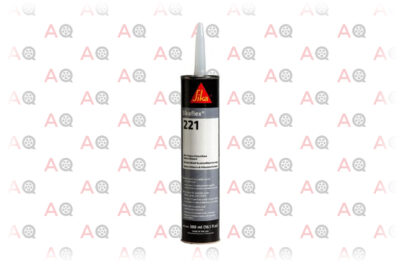
Editor’s Rating:
Quick Facts:
- Type: Polyurethane Silicone
- Consistency: Putty
- Sealant / Coating: Sealant
- Compatible With: Everything
- Color: White
- Size: 10 ounces
Coming in at over $1.50 per ounce (no bulk buy discounts available here), Sikaflex doesn’t come cheap, not by any stretch of the imagination. But this awesome product is worth every last penny because there’s nothing stronger out there on the market.
Ask any automotive repairer what they use to fix leaky roofs and walls, and chances are they’ll tell you Sikaflex is the way to go. And the good news is this product works just as well on your RV, allowing you to apply a permanent elastic adhesion to your roof that won’t cut or tear over time—Sikaflex is specifically designed to absorb the shocks and bumps of the road.
This brilliant product is weatherproof and works well in both hot and cold climates. Once it’s been cured, It’s even safe if it comes into contact with potable water and food.
However, be aware that the stuff has a nasty habit of spreading itself everywhere upon installation and is a massive pain to remove. Be sure to apply Sikaflex exceptionally slowly and carefully to avoid accidentally sealing a whole bunch of things you didn’t want to.
On the plus side, you can always sand it back or paint over it when you inevitably make a mess.
Pro tip: Wrap cellophane around the end of the tube and store it in the fridge and you’ll be able to reuse it many months later.
Pros
- Strongest sealant on the market
- Works well in all situations
- Resistant to hot and cold conditions
- Doesn’t cut or tear on the road
- Safe for contact with drinking water or food
Cons
- Very messy
- Hard to remove
- Expensive

Editor’s Rating:
Quick Facts:
- Type: Acrylic
- Consistency: Liquid
- Sealant / Coating: Both
- Compatible With: All Types of Rubber
- Color: White
- Size: One Gallon
Heng makes one of the most popular RV sealants and coatings for rubber roofs on the market, and it’s little wonder this product is a hit because it works incredibly well. The acrylic-based liquid slips easily into tiny crevices to seal problematic rubber roofs; it also serves as a powerful coating for enhanced UV protection. What’s more, it expands and contracts with your roof over time, which means it simply lasts longer than other products out there.
Got an issue with a leaky air-conditioner or vent? This product will sort you out in a jiffy as it’s excellent for these kinds of applications. And if you’re worried about safety, rest assured Heng make a non-polluting and non-toxic sealant that won’t make you dizzy or ill.
Although applying a primer will help the process along, it’s not strictly necessary. You could use the formula on its own and still achieve a strong seal, which dramatically reduces the time and cost of the process.
While the product costs more than most other coatings, note that it comes in a sizable one-gallon container. Therefore, if you plan to recoat your roof several times, it actually works out to be pretty good value for money.
On the downside, the acrylic formula won’t offer the same level of protection as silicone. Furthermore, it only works on rubber roofing, so give it a miss if you’re rocking fiberglass or the like.
Pros
- Sealant and coating in one
- Expands and contracts with your roof
- Safe formula to work with
- Can be done in one application
- Slips into small cracks
Cons
- Works better with primer
- Acrylic not as good as silicone
- Only works on rubber roofs
3. Best Budget RV Sealant and Coating: Dicor 501LSW-1

Editor’s Rating:
Quick Facts:
- Type: Self-leveling silicone
- Consistency: Putty
- Sealant / Coating: Sealant
- Compatible With: EPDM and TPO sheeting
- Color: Creamy white
- Size: 10.3 fluid ounces
If budget is your primary consideration when fixing a leaky roof, the Dicor 501LSW-1 is worth considering. This affordable solution works well on air vents, pipes, and cracks and will get the job done for a minimal cost.
The product is compatible with both EDPM and TPO type rubber, meaning it’s good to go on most RV roofs. Aside from rubber, it’ll also bond to various other materials, including concrete, aluminum, fiberglass, and mortar. And don’t be put off by the fact it’s self-leveling because you rarely need to make any vertical applications when working on a roof.
This one comes in a nice creamy white color that blends seamlessly with most RV roofs, although the option is there to pick other colors if necessary.
The sealant is pretty easy to apply, typically taking five minutes once the area is ready to work with. Waterproofing requires a four-hour wait, and you’ll need to wait 48 hours in total before it’s 80% cured. The catch? You’ll have to wait a whole month before it’s fully (100%) cured.
It comes in a tiny 10-ounce tub, so grab a few if you need to do a big repair job.
Pros
- Very cheap
- Compatible with all standard RV roofs
- Works well on various leaks
- Multiple colors available
Cons
- Small package size
- Takes a while to cure
4. Best Multipurpose RV Sealant: Flex Seal Liquid Rubber
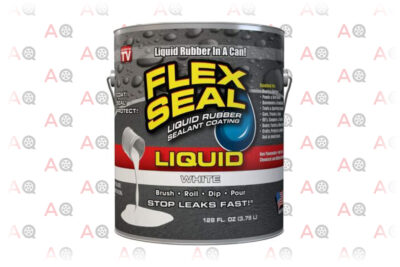
Editor’s Rating:
Quick Facts:
- Type: Acrylic
- Consistency: Liquid
- Sealant / Coating: Both
- Compatible With: Rubber
- Color: White
- Size: 1 gallon
It’s “like liquid rubber in a can,” as the manufacturers say, and they’re not far off the mark. This widely popular product is a hit among DYI home improvement types for its sheer versatility—you can use it to coat or seal just about any kind of rubber imaginable. Waterproofing and weatherproofing a rubber surface is super easy thanks to its spreadable liquid-like consistency, which you can roll, brush, dip, or pour all over the desired area.
Despite how simple the product may seem, it works remarkably well, sealing out air, water, and moisture with ease while preventing mildew and corrosion.
Flex Seal Liquid Rubber is safe to work with, with no flammable, toxic, or hazardous components to speak of. Feel free to use this one around plants and animals without fretting about their wellbeing.
The secret to its user-friendly success is the thin consistency, but be aware it does come with a downside. You’ll likely need to apply the product up to three times to create a satisfactory seal or coat, and that requires a substantial amount of extra time and effort.
Pros
- Versatile product suitable for multiple purposes
- Easy to use liquid with a thin consistency
- Effective at preventing moisture, mildew, and corrosion
- Safe product to work with, even around plants and animals
Cons
- Requires up to three coats for optimal effectiveness
5. Best RV Tape Sealant: EternaBond RSW-2-50 RoofSeal Sealant Tape

Editor’s Rating:
Quick Facts:
- Consistency: Tape
- Sealant / Coating: Sealant
- Compatible With: Everything
- Color: White
- Size: 2″ x 50″
Although liquid and putty-style sealants tend to be the most effective, tape is an option when the affected area is nice and flat. And as you might expect, it’s a whole lot easier to apply than an ultra-sticky putty or gooey liquid.
Several sealant tapes are available on the market, many of which will work well on the roof of your RV. But the product that stands out from the crowd for its superior sealing properties is the EternaBond RSW-2-50 from RoofSeal.
EternaBond consists of a clever concoction of synthetic resins, thermoplastics, non-curing rubber, and a primer. The result is a high elongation level that allows it to contract and expand without compromising its adhesiveness. While the white finish works wonders at reflecting sunlight, it will appear a little odd if you don’t have a white car.
If you weren’t aware, with tape, you still have to clean the surface thoroughly with Isopropyl Alcohol. But once that’s done and dusted, all that’s left to do is peel off the protective silicone lining and carefully position the tape in place.
A word of warning, though: the stuff is super susceptible to the elements. Don’t use this on a wet day, and keep your RV in a sheltered place for at least a week after the application. Otherwise, you could inadvertently trap water droplets underneath the tape, which will eventually cause it to fray and decay.
If you don’t think two inches will be wide enough, rest assured the product comes in four and six-inch variations as well.
Pros
- Excellent sealing properties
- Easy to use and can be applied in minutes
- Contracts and expands without losing adhesiveness
- White finish reflects sunlight
- Available in multiple sizes
Cons
- Not as powerful as liquids or putties
- Only works well on flat surfaces
- Highly susceptible to water and snow
6. Best RV Roof Rubber Coating: KST Coating Elastomeric Finish Coat
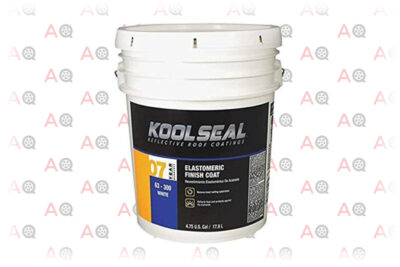
Editor’s Rating:
Quick Facts:
- Type: Acrylic resin
- Consistency: Liquid
- Sealant / Coating: Coating
- Compatible With: Rubber
- Color: White
- Size: 4.75 gallon
“Prevention is better than cure,” as the old saying goes. And rather than waiting for a hole to appear in an RV roof and water to start gushing through, savvy RVers apply a protective coating ahead of time to stop cracks in their tracks.
While RV sealants work wonders at filling in holes and gaps, RV roof coatings are designed to be applied over the entire roof to strengthen its integrity. KST doesn’t lose adhesiveness in adverse weather and will expand and contract to retain optimal flexibility.
A high-quality coating such as this will enhance the UV and water-resistant properties of your roof thanks to its potent elastomeric finish. Furthermore, this outstanding American-made product protects against algae, mildew, mold, and moisture, making it ideal for folks in hot and humid environments—it’s a big hit in Florida, for example.
The manufacturers back the product with an extensive seven-year warranty, which helps reassure customers who may balk at the hefty price tag. The main drawback is the product comes in an enormous (and expensive) 4.75-gallon tin that covers a whopping 1500 sq ft., big enough to coat a small house—don’t worry, the product works fine on all rubber roof RVs as well.
Another downside is that elastomeric coatings tend to dry in thin layers, and this model from KST is no exception. You’ll need to apply at least two coats (a base coat before the white coat) to achieve optimal protection.
Pros
- Excellent elastomeric coating for RVs
- Perfect for humid environments
- Protects against the sun and the rain
- Remains adhesive and flexible in adverse weather
Cons
- Requires two coats for optimal performance
- Rather expensive
- Comes in a massive tin that’s more than you need
7. Best for Fiberglass Roofs: Dicor Fiberglass RV Roof Coating

Editor’s Rating:
Quick Facts:
- Type: Acrylic resin
- Consistency: Liquid
- Sealant / Coating: Coating
- Compatible With: Fiberglass
- Color: White
- Size: 1 gallon / 350 sq ft.
While the KST Coating Elastomeric Finish Coat is your best bet for a rubber RV roof coating, this nifty product from Dicor is the ideal way to make your fiberglass last. The specially formulated acrylic resin mixture has been purposely designed with the fiberglass RV roof in mind, allowing it to provide ample protection and a long-lasting shine.
This formula is entirely free of ingredients that can damage delicate fiberglass, including petroleum distillates. Therefore, it’s safe to use on your fiberglass roof without the risk of corrosion.
Most RV coatings tend to lose their sheen over time, but this product from Dicor offers a persistent bright white finish that doesn’t tend to fade. It’ll also reflect the sun’s UV rays to help keep your RV cooler—a godsend in summer—and provide protection from algae and mildew.
Like other acrylic resin roof coatings, you’ll need to apply two coats to get the job done and wait for a considerable amount of time before it’s dry. Nonetheless, it’s well worth the effort to keep your fiberglass roof in tip-top condition for the season to come.
But buyer beware: be sure to apply it as you’re heading into the warmer months. Pure acrylic resin coatings tend to peel and crack when the temperature dips below freezing.
Pros
- Specially designed fiberglass RV coating
- Resists mold and mildew
- Protects from UV rays
- Retains long-lasting sheen
Cons
- Requires two coats
- May peel over winter
8. Best for Metal Roofs: Dicor RP-MRC-1 Elastomeric Coating

Editor’s Rating:
Quick Facts:
- Type: Acrylic resin
- Consistency: Liquid
- Sealant / Coating: Coating
- Compatible With: Metal
- Color: Arctic white
- Size: 1 gallon
Dicor makes our favorite fiberglass RV coating, and the company is on the money with their metallic version as well. Once again, Dicor has specially designed this product for optimal performance with a specific roof type—in this case, metal. Therefore, RV owners looking for a way to coat their aluminum roof can rest assured they’re making the right choice.
The 100% acrylic elastomeric resin dries into a rubber-like coating that does an excellent job of protecting metal surfaces from the elements. Resistant to both mold and mildew, the coating expands and contracts as your roof rattles around to ensure it can stand the test of time. It’ll also reduce the likelihood of cracks forming in your roof, thus preventing potentially damaging leaks.
The bright white finish, which is almost identical to the fiberglass coating, reflects the sun’s rays. However, it may start to look dirty quicker than other products, but that’s nothing a vigorous scrub with soapy water can’t fix.
You’ll need to add two coats for optimal performance; the one-gallon tin is good for up to 200 sq ft. As you’re working with metal here, remember to treat any rust first and apply a primer. The coating should only be applied when the temperature is higher than 50F.
Pros
- Ideal coating for metallic RV roofs
- Expands and contracts
- Mold and mildew resistant
- Reflects sun’s rays
- Prevents cracks from forming
Cons
- Starts to look dirty quite quickly
- Requires rust removal, priming, and multiple coats
- Can’t be applied in cold weather
9. Best Transparent RV Sealant: Geocel GC28100 Pro Flex RV

Editor’s Rating:
Quick Facts:
- Type: Silicone
- Consistency: Putty
- Sealant / Coating: Sealant
- Compatible With: Fiberglass and aluminum
- Color: Transparent
- Size: 10 fluid ounces
If you’ve got a uniquely-colored RV, then the last thing you want to do is seal up your roof with a standard white or cream sealant. And that’s where the GC28100 Pro Flex from Geocol comes in, with its transparent texture that works well on any colored RV.
Before you get too excited, do be aware the sealant isn’t entirely invisible. You’ll still be able to notice it if you look closely and carefully, especially should you fail to apply it in a smooth, even coat. You can paint over the top of it, though, which is perfect should you decide you’re not quite happy with the outcome.
Nonetheless, in terms of aesthetics, it easily outperforms any white sealant for colored RV roofs.
Aside from being see-through, the GC28100 Pro Flex is a pretty decent sealant. The silicone-based product is remarkably flexible and resistant to cracking, plus it’ll retain its adhesiveness in even the toughest weather conditions. It’s durable, too; the sturdy sealant resists mildew and mold for up to 25 years.
Novice roof sealers also love how easy this product is to apply. Unlike other more powerful sealants—we’re looking at you, Sikaflex—the Pro Flex isn’t wild and stringy, so you won’t have to make an ungodly mess. And if you do happen to squirt a bit of stray goo where you shouldn’t have, it’s relatively easy to clean up again.
This product works well with fiberglass and aluminum, although it’s not suitable for rubber RV roofs.
Pros
- Transparent for use on any roof color
- 25-year lifespan
- Protects against UV, mold, and mildew
- Resistant to cracking
- Easy to apply and clean
Cons
- Not suitable for rubber roofs
10. Best Self-Leveling Sealant: ToughGrade Self-Leveling RV Lap Sealant
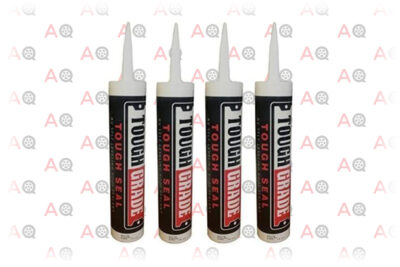
Editor’s Rating:
Quick Facts:
- Type: Self-leveling silicone
- Consistency: Putty
- Sealant / Coating: Sealant
- Compatible With: Rubber
- Color: White
- Size: 4x 10-ounce tubes
This rubber self-leveling sealant is an excellent option for RV roofs with stubborn leaks and cracks that are difficult to reach. The tiny tube slides into a caulking gun for easy application in inaccessible places and will level itself with time for a smoother finish. Use it to seal vents, pipes, holes, cracks, and crevices in your roof, virtually anywhere on a horizontal plane.
Do note, however, that self-leveling sealants cannot be used on horizontal surfaces—give this one a miss if you also plan on sealing your RV windows.
ToughGrade can withstand the elements without cracking or peeling, even in freezing conditions and bucket loads of snow.
It’s simple for the layman to apply as well—all you’ve got to do is clean the area and squirt it on. What’s more, it dries super quickly, and you can paint over the top of it to achieve your desired look. That’s just as well because the sealant comes in an unusual off-white color that doesn’t blend well with your standard RV roof.
Pros
- Excellent for horizontal applications
- Doesn’t degrade over time
- Doesn’t degrade over time
- Dries fast
- Can be painted over
Cons
- Off-white color doesn’t match most roofs
RV Roof Sealants and Coatings: A Buyer’s Guide
Before you take the plunge and purchase a sealant or coating to fix your RV, it’s worth doing your research to learn everything you can about the products and processes. In this in-depth buyer’s guide, we’ll explain in detail the different types of sealants/coatings and roofs, as well as how to fix a leaky RV roof on your own.
What’s the Difference Between RV Sealants and RV Coatings?
Contrary to popular belief, there is a notable difference between RV sealants and RV coatings.
As the name implies, sealants are specially designed to seal any cracks that may have formed in your roof due to wear and tear on the road. These highly malleable and weather-resistant products are ideal for fixing a leaky roof to keep your RV—and the contents within—dry.
Coatings, on the other hand, are intended to be painted or sprayed over the top of your RV roof. These preventative products enhance the structural integrity of your roof and increase its UV and weather-resistant properties.
While liquid coatings can seal minor cracks in a roof, silicone-based sealants are always more effective. Of course, using a putty-like adhesive such as silicone to coat your entire roof would be hilariously inefficient, so you’d need to purchase a separate product if you want a weather-resistant coating as well.
Although many RVers may apply a sealant and a coating simultaneously, the two products serve distinct purposes.
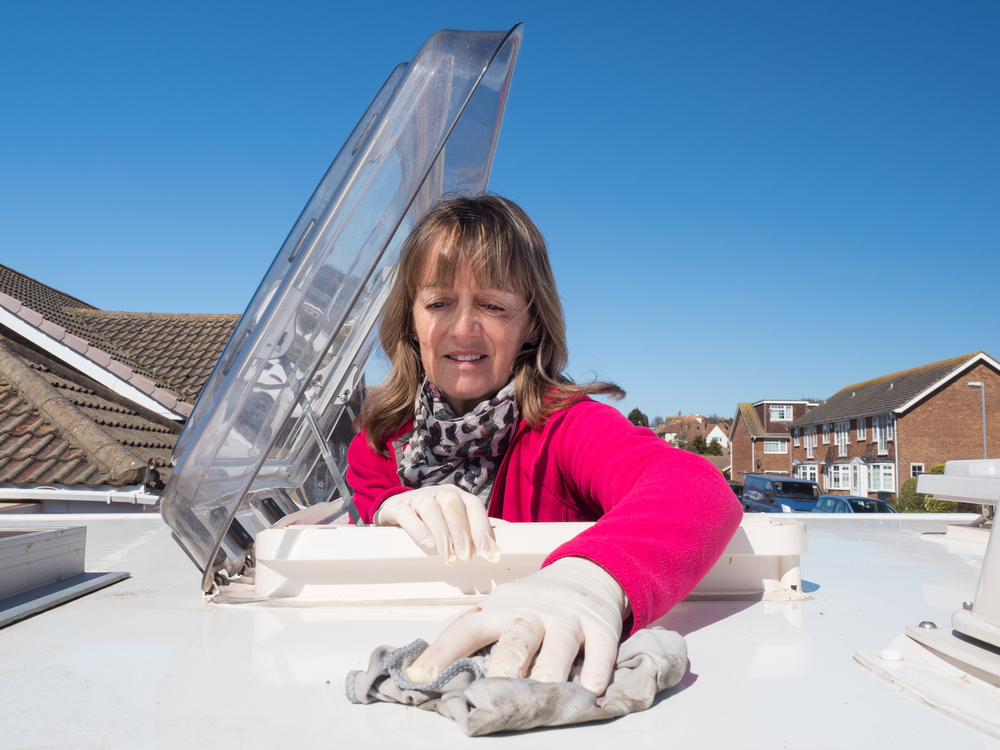
The Benefits of Sealing and Coating Your RV
Even a low-cost RV requires a considerable financial outlay, so it makes sense to do everything you can to protect your investment. And one of the easiest ways to degrade an RV over time is by neglecting to maintain its roof.
Life on the road involves millions of rattles and bumps, each of which takes a tiny toll on the structural integrity of your RV. But when combined over a prolonged period, these little rumbles eventually form cracks in the membrane of your roofing. Naturally, the first place to come apart is the sealant, which, when compromised, will allow water to gush through your roof and into your RV.
If left as is, that water flow will rot your wood, rust your steel, and fry your electrics—potentially costing you thousands of dollars in repairs over time. The best way to avoid forking out for an eye-watering repair bill is by sealing the roof of your RV religiously.
Aside from keeping water out, a properly sealed and coated RV roof will improve your overall insulation, thus making it more energy-efficient to heat or cool your mobile home.
RV Roof Sealant and Coatings Formulas
There are three main varieties of RV sealants to choose from, each with distinct pros and cons. No one particular type is the best for every situation, so you’ll have to study these carefully to determine which is best for you.
Silicone Sealants
Silicone automotive sealants are among the most expensive on the market, but they’re also among the most durable. These heavy-duty sealants hold up exceptionally well against the elements, capable of withstanding even the most fierce wind, rain, and sun. An elastic-like structure enables these sealants to hold steady through the bumps of the road, making them a popular choice among automotive repairers and RV enthusiasts.
On the downside, silicone has a nasty habit of getting everywhere, so it’s a bit tricky to apply, despite the fact you only need one coat. It’s also more expensive than other sealant types and tends to get all gunky and dirty looking rather quickly.
Acrylic Sealants
Acrylic sealants are exceptionally affordable but take a long time to apply, making them a suitable option for cash strapped but time-rich RVers who are willing to fix their own roof. The liquid-like substance does a decent job of reflecting sunlight and sealing in cracks and gaps, although it isn’t as waterproof as other options.
If you live in a wet region or expect water to pool on the roof of your RV, then consider trying a different variety. Acrylic takes longer to apply as you’ll need to do a primer and then put on a second coat known as a ‘fabric reinforce.’
Urethane Sealants
Urethane is an excellent RV sealant for its superb weather-resistant properties that enable it to withstand the test of time in even the harshest American climates. The substance dries out to create a durable shell capable of taking a beating from physical objects like pine cones and hail. Of course, no sealant is bulletproof, so don’t expect a fresh layer of urethane to protect your roof from heavy impacts.
Urethane costs quite a bit more than other sealants and takes longer to apply because two coats are needed for the optimal finish. Nonetheless, many RVers believe it’s worth the extra time and money for the additional protection it affords.
RV Roof Sealant and Coating Consistency
RV sealants and coatings come in various consistencies, each of which serves a distinct purpose.
Putty
Silicone-based sealants have a putty-like consistency, best applied through a caulking gun. As the putty is thick and expensive, it’s only ever used to seal problematic areas—never to coat an entire roof.
Some silicone sealants are self-leveling, which means they’re only useful on a horizontal surface.
Liquid
RV coatings come in a liquid consistency, which you can paint over the entire surface area of your roof. The texture is kind of like a varnish, and the application process is somewhat similar as well.
Although a coating may help seal smaller cracks on your RV roof, they’re never as effective as dedicated sealants. Therefore, if you’ve got a giant gap that needs urgent attention, it’s best to use a silicone sealant before applying a protective coating to the entire roof.
Tape
As the name implies, sealant tapes are a tape-like product that appears almost identical to duct tape or the like. However, the product is different in that it’s specially designed to seal rubber surfaces together, making it a suitable solution for cracks in the flat areas of your RV roof.
Sealant tape isn’t useful in the non-flat areas, though, as water will always find a way to wiggle underneath. On the whole, it isn’t as effective as other sealant types either, so this “easy option” is best left for minor cracks and gaps.
Our favorite RV sealant tape is the EternaBond RSW-2-50 RoofSeal Sealant Tape.
RV Roofing Materials
The ideal RV sealant or coating depends on what your roof is made out of, which typically falls into one of four categories: EPDM rubber, TPO rubber, fiberglass, and aluminum.
EPDM Rubber
Ethylene Propylene Diene Monomer is lightweight and cheap but doesn’t compare with other roof types in terms of durability. This kind of rubber simply isn’t strong enough to withstand heavy weight or constant impacts, which means you’ll need to repair it more frequently. If you’ve got an EPDM rubber roof on your RV, you might notice how it starts to appear a tad rusty and chalky over time as well.
TPO Rubber
A superior, albeit more expensive, type of rubber to use on an RV roof is TPO, which stands for Thermal Poly Olefin. This rubber is far more rigid than EPDM, so you generally won’t have to reseal it quite as often. The easiest way to identify TPO rubber is by its glossy sheen, which continues to shine for many years after leaving the factory floor.
Fiberglass
Although fiberglass RV roofs exist, they’re not nearly as common as either of the two main rubber varieties. Much like EPDM, fiberglass tends to oxidize and lose its aesthetic appeal over time. The good news is you can rapidly remedy the issue with a fresh new RV coating, which should instantly return its glossy shine.
Our favorite sealing and coating to use on fiberglass roofing is Dicor Fiberglass RV Roof Coating.
Aluminum
Aluminum is the least common of the four main RV roof types, mostly because this heavy material adds too much extra weight to the rig. The plus side is that aluminum is far more rigid than other roof types on the market, so you shouldn’t have to bother sealing it for many years to come.
Coating aluminum is always worthwhile, however, and our favorite product is Dicor RP-MRC-1 Elastomeric Coating.
Applying a Sealant and Coating to Your RV Roof
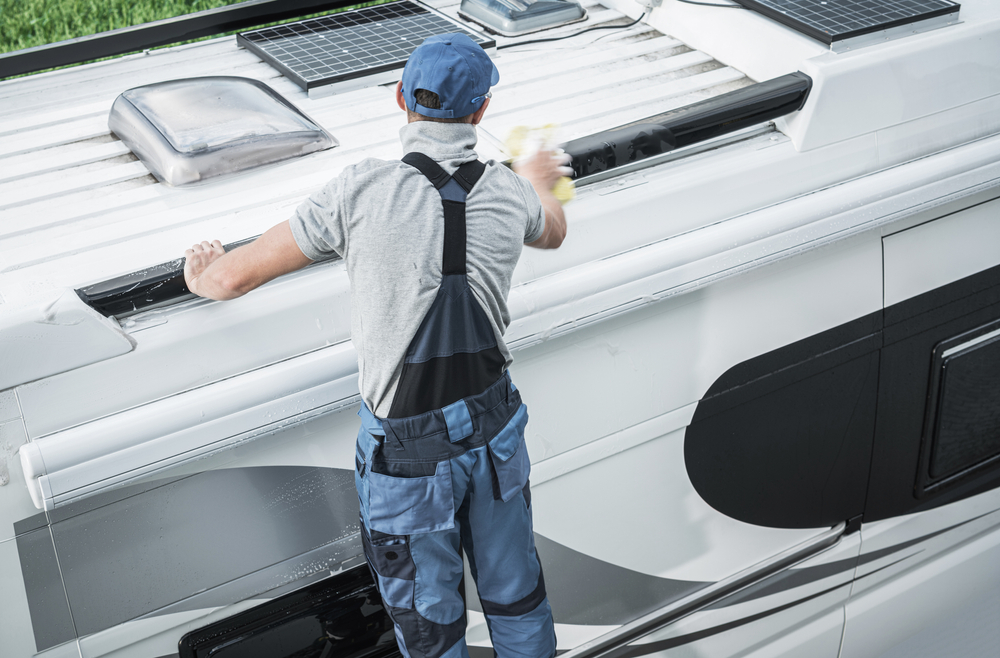
Although the process of applying a coating or sealant to your RV roof varies significantly depending on the particular product, there are several fundamental steps to follow.
How to Seal an RV Roof
- Strip away the layer of sealant you plan to replace using a Stanley knife or similar tool.
- Level the area using sandpaper
- Clean the area using a sponge or cloth with denatured alcohol
- Stick masking tape alongside the area you want to seal to avoid getting sealant where you shouldn’t
- Apply the sealant slowly and carefully in an even layer
- Allow the sealant to dry for 24 hours in a shady place protected from the wind and the rain (don’t drive until it’s dry)
Many sealants like silicone are easier to apply with a caulking gun, which you can purchase online or pick up from your local hardware store. If you plan to go down this route, opt for a sealant in a package that’s already compatible with a caulking gun.
If you’re still not confident, here’s a more in-depth article on how to seal your RV roof.
How to Coat an RV Roof
Follow these steps to coat your RV roof:
- If necessary, seal up any cracks in your RV roof using a sealant
- Use a stiff-bristled broom and warm water with detergent to clean your RV roof thoroughly
- Allow your RV roof to fully dry, leaving it in the sun for many hours or even overnight if necessary
- Apply your coating smoothly and evenly using a roller brush or paintbrush
- Apply a second coat 24 hours later if necessary
Although RV coatings can help seal cracks and crevices, they’re not as powerful as a dedicated sealant. Therefore, to fix severe damage, it’s wise to use a sealant first and let it dry before coating the roof.
Remember to clean your roof exceptionally well, as an RV coating won’t stick to a dirty surface.
More information on how to coat your RV roof can be found in this article.
RV Sealant and Coating FAQ
If you’ve still got questions about RV sealants and coatings, then take a look at the following FAQ.
What Is the Best RV Sealant?
While the ideal sealant depends on several factors, including the roof type and the extent of the damage, our favorite overall is Sikaflex-221. This widely popular automotive sealant does a fantastic job of patching up a leaky roof, even though it may be a bit messy to apply.
How Often Should You Seal Your RV Roof?
A leaky roof can cause extensive damage to your RV electrics, as well as rot away your wood and cause your metal to corrode. Because the bumps of the road make the joints in your roof unravel at a rapid pace, most veteran RVers will take the time to reseal their RV roof at least once per year.
Many RVers also opt to recoat their roof at the same time, reinforcing it to provide extra rain and sun protection for the travel season to come.
How Do You Remove Old Roof Sealant From RV?
You’ll need to get rid of the old sealant before applying a new batch. Use a Stanley knife to cut out the old adhesive, then sand it back vigorously with sandpaper.
Once it looks nice and level, remember to clean the surface with denatured alcohol and let that dry before applying the new sealant.
Can I Walk on My RV?
Most people can safely walk on most RV roofs, as these are typically rated to support the weight of the average human.
However, we still recommend you read the owner’s manual of your vehicle to double-check the load rating of your roof. The last thing you want to do is fall through and cause severe damage to both you and your rig.
Final Thoughts
There you have it—everything you could ever hope to know about RV roof sealants and coatings, and can do your own maintenance. Sure, you could pay a professional to do it for you. But these services typically cost north of a grand. Do it yourself, however, and you’ll be done within an afternoon and will have saved yourself a massive wad of cash (which you can spend on the road!).
Whether you’re looking to reseal your old, weathered sealant, or reinforce your roof with a fresh layer of protective RV coating, we’ve recommended the best options on the market for you.
After a small financial investment and a bit of good old fashioned elbow grease, you can relax safe in the knowledge your RV roof is now good to go for the season to come. If you’re looking to further prepare your RV before the big trip, you can take a look at our article about RV waxes too.
Happy trails, folks.


